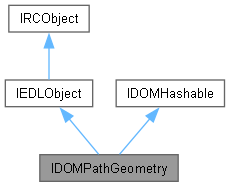Interface to the path figure element. A path figure is a single shape comprised of continuous path segments. One or more path figures collectively define an entire path geometry. A path geometry may define the fill algorithm to be used on the component path figures. Instances of this type use exceptions of IEDLError for error handling.
More...
|
| virtual bool | getIsClosed () const =0 |
| | Retrieves IsClosed for the path figure. IsClosed specifies whether the path is closed, that is, whether the last point in the last segment of the path figure should be connected to the start point of the figure, otherwise the stroke is drawn open, and the last point is not connected to the start point. This is only applicable if the path figure is used in a Path that specifies a stroke.
|
| |
| virtual void | setIsClosed (bool closed)=0 |
| | Sets IsClosed for the path figure. IsClosed specifies whether the path is closed. When this is set to true it specifies that the path is closed-thatis, the last point in the PathFigure is connected to the first. An exception is thrown if this segment is immutable.
|
| |
| virtual const FPoint & | getStartPoint () const =0 |
| | Retrieves the start point for the first segment in the figure.
|
| |
| virtual void | setStartPoint (const FPoint &sp)=0 |
| | Sets the start point for the first segment in the figure. An exception is thrown if this segment is immutable.
|
| |
| virtual bool | getIsFilled () const =0 |
| | Retrieves IsFilled for the figure. IsFilled specifies whether the path figure is used in computing the area of the containing path geometry. When set to false, the path figure is considered only for stroking.
|
| |
| virtual void | setIsFilled (bool filled)=0 |
| | Sets IsFilled for the figure. IsFilled specifies whether the path figure is used in computing the area of the containing path geometry. When set to false, the path figure is considered only for stroking. An exception is thrown if this segment is immutable.
|
| |
| virtual const CDOMPathSegmentVect & | getSegments () const =0 |
| | Retrieves the collection of segments that comprise this path figure.
|
| |
| virtual uint32 | getSegmentsCount () const =0 |
| | Retrieves the number of path segments in the figure.
|
| |
|
virtual void | clearSegments ()=0 |
| | Removes all path segments from the figure. An exception is thrown if this segment is immutable.
|
| |
| virtual void | addSegment (const IDOMPathSegmentPtr &pathSegment)=0 |
| | Append a path segment to the figure. An exception is thrown if this segment is immutable.
|
| |
| virtual FRect | getBounds () const =0 |
| | Finds the conservative bounding box of the figure.
|
| |
| virtual bool | getIsImmutable () const =0 |
| | Determine if the segment is immutable (non-editable).
|
| |
|
virtual void | setImmutable ()=0 |
| | Force the segment to be flagged immutable.
|
| |
| virtual const CClassID & | getClassID () const =0 |
| | Returns class ID of IEDLObject.
|
| |
| virtual bool | init (CClassParams *pData) |
| | The init() method is called to perform any post-construction initialization of an IEDLObject that has been created by the EDL class factory, before it is actually returned by the factory.
|
| |
| virtual bool | clone (IEDLObjectPtr &ptrObject, IEDLClassFactory *pFactory) |
| | Create a copy of EDLObject.
|
| |
|
virtual void | addRef () const =0 |
| | Increases the reference count of the actual object pointed to. This would take place during an assignment or copying.
|
| |
| virtual bool | decRef () const =0 |
| | Decreases the reference count of the actual object pointed to. When the reference count falls to Zero, it deletes the actual object pointed to.
|
| |
| virtual int32 | getRefCount () const =0 |
| | Retrieve the current reference count of the actual object pointed to.
|
| |
|
virtual | ~IDOMHashable () |
| | Virtual destructor.
|
| |
| virtual bool | hash (uint64 &hash)=0 |
| | Retrieve a hash for this object.
|
| |
| virtual uint64 | hashE () |
| | As hash(), but throws an exception if the operation fails.
|
| |
Interface to the path figure element. A path figure is a single shape comprised of continuous path segments. One or more path figures collectively define an entire path geometry. A path geometry may define the fill algorithm to be used on the component path figures. Instances of this type use exceptions of IEDLError for error handling.
- See also
- IDOMPathNode
-
IDOMPathSegment
-
IDOMPathGeometry

 Public Member Functions inherited from IEDLObject
Public Member Functions inherited from IEDLObject Public Member Functions inherited from IRCObject
Public Member Functions inherited from IRCObject Public Member Functions inherited from IDOMHashable
Public Member Functions inherited from IDOMHashable Protected Member Functions inherited from IRCObject
Protected Member Functions inherited from IRCObject